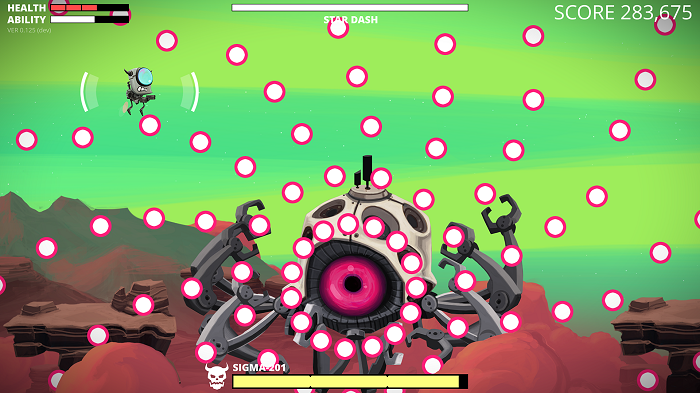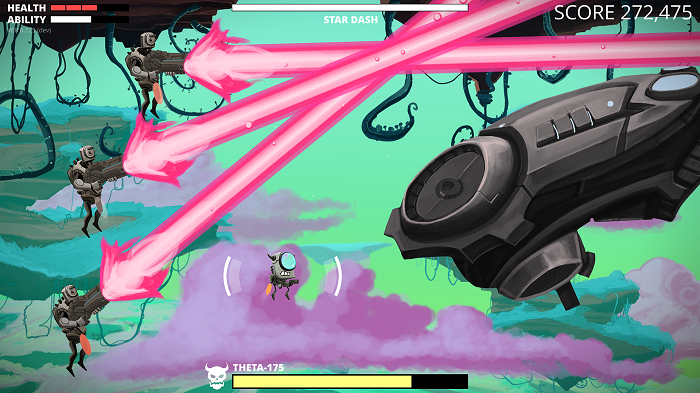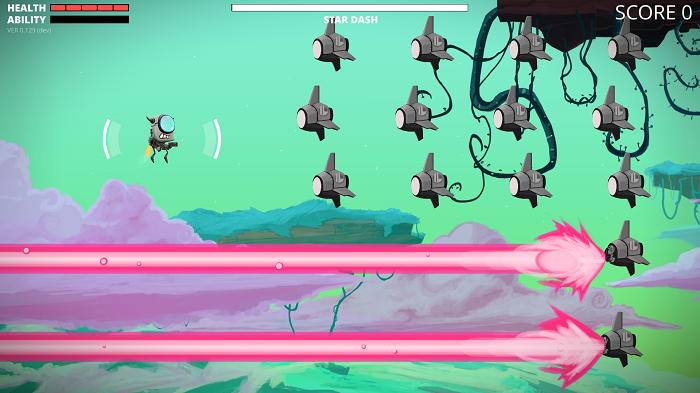Legacy of the Elder Star, Kickbomb Entertainment’s new action game described as “a side-scrolling shooter inspired by classic CAVE and Treasure shmups” is slated for release sometime this spring. It recently made an appearance in the indie games section of MAGFest. What makes this game different from other shoot-em-ups? I’ll let them tell it:
Become the Cosmonaut, mythic hero of the stars, and defend the universe against the Infinite Legion in this fast-paced arcade shooter featuring unique mouse-driven movement, dynamic enemy patterns, unlockable weapons, and online leaderboards!
Legacy of the Elder Star is a shoot-em-up (AKA “shmup”) in the tradition of Gradius and R-Type, but with one key difference: this game is controlled exclusively with the mouse. 1:1 mouse control provides a level of fluidity and precision rarely seen in the genre, and that’s nowhere more evident than in the Cosmonaut’s unique “star dash” attack: simply click and drag through multiple foes to destroy them all!
We recently spoke to Josh Sutphin – founder of Kickbomb Entertainment and creator of Legacy of the Elder Star – about the game, its accessibility, and what makes it unique, as well as the growing indie game dev scene in Utah.
Zanne Nilsson: One of the things that sets Legacy of the Elder Star apart is its accessibility. In what ways did you try to make this game accessible to all players?
Josh Sutphin: The game is played solely with the mouse, which means it’s completely playable with one hand. Some gamers can’t play with both hands, for any number of reasons; it seems a shame that they’re so often excluded from action games as a result, so we tried to address that problem with Legacy of the Elder Star.
We’re also planning to include a bunch of increasingly-common accessibility options in-game, like special rendering modes for colorblind players, the ability to turn off screen flashes for epileptic players, a scalar for camera shake intensity for those who are more sensitive to motion sickness, etc.
ZN: What was the inspiration behind Legacy of the Elder Star‘s story?
JS: The shmup genre tends to hit a lot of the same themes over and over again: spaceships and anime girls in particular. Those are cool, but we wanted to do something unique.
I’ve long been fascinated by the idea of the Big Bang, the event that science currently believes created the universe as we know it. If the Big Bang was an explosion, it begs the question: what exploded? I’m totally embracing speculative pseudo-science when I say that I can’t help but see the Big Bang as the first-ever star going supernova. That “first star in the universe” concept became the titular Elder Star. The “legacy” of the title is the game’s protagonist, the Cosmonaut, a mythic hero spawned from the Elder Star to protect it from the assault of the robotic Infinite Legion.
There was a lot more complicated pseudo-science-y stuff in an earlier draft, but we pared it down a lot because the story was starting to get in the way of the gameplay. At the end of the day, you don’t play a shmup to watch cutscenes and read dialog; you play it to blow shit up.
ZN: Why did you decide to emphasize offense over dodging in the gameplay?
JS: Over the past decade shmups have trended increasingly toward danmaku or “bullet hell”, typified by games like DoDonPachi, Mushihimesama, and much of the Touhou series. These are games that literally fill the screen with bullets, putting the gameplay focus squarely on learning each pattern’s “safe spot” and reacting with micro-movements to inch your way through the bullet field.
Those games are cool, but they’re incredibly intimidating to genre newcomers and they demand an enormous amount of training before you can start posting competitive scores. I’ve talked to loads of players who like the idea of shmups but feel like they’re nowhere near skilled enough to play these bullet hell games. I really wanted to make a shmup for those players.
At first, the game was about dodging bullets; it just had much easier patterns. It turns out that’s actually pretty boring; there’s a good design reason why bullet hell has trended the way it has. By shifting the gameplay focus away from dodging and more to offense – how quickly and efficiently you can clear enemy squads – I was able to create an experience that takes just as much skill to score well at but far less skill to simply survive. That’s made a game that beginners seem to really enjoy (because they’re not kicked to a “game over” screen every 30 seconds) but which still has enough mechanical depth to keep skilled, competitive players hooked.
ZN: One of the unique aspects of the gameplay is the star dash mechanic. Why did you add this attack in particular?
JS: The star dash works by holding the right mouse button then dragging through enemies: anything you hit takes damage, and you’re immune to enemy bullets for the duration. You can quickly “slash” or “scribble” through patterns to wipe out lots of enemies in a quick, organic gesture.
The star dash came from a desire to do something really iconic our 1:1 mouse-based control scheme. Up to that point there was nothing in the game you couldn’t also do just as well on a keyboard or an arcade stick. The mouse-based control is completely unique to our game and I wanted to make sure it mapped to a unique core gameplay feature as well, rather than just being some weird little gimmick.
ZN: What’s your favorite thing about Legacy of the Elder Star?
JS: I’m incredibly happy with the unique art style Erik Exeter brought to the game; I think it’s beautifully executed and it really gives the game a standout look and feel. I’m also really proud of the breaks- and chiptune-inspired soundtrack I’ve written, and I’m super stoked at how intuitive and satisfying the gameplay has turned out to be.
But my absolute favorite thing about Legacy of the Elder Star has to be that we’ve made this game with zero “crunch time”. My past experiences in the game dev industry are littered with months-long periods of 70-hour weeks to get projects out the door; ask any game developer and you’ll hear similar stories. Crunch is a cancer on our industry, and one of my core goals when I founded Kickbomb Entertainment was to prove that great games can be made on sustainable, sensible schedules, without crunch. It remains to be seen whether Legacy of the Elder Star will be perceived as a “great game”, but we’ve made something I’m honestly proud of and we’ve done it without killing ourselves in the process, and that feels important.
ZN: You also co-founded the Utah Games Guild a couple of years ago to grow Utah’s indie game development scene. What excites you the most about Utah’s indie game community?
JS: The Utah indie community is a powder keg of innovation that’s just waiting for the right spark. Most people I’ve met in the games industry don’t give Utah much thought as a game dev hub, whether AAA or indie. But the fact is, we have mainstream studios like Epic, EA, and Disney; successful mid-sized studios like WildWorks and NinjaBee; the #1 game dev university program in the nation; and 200+ active indie developers in a community that’s constantly growing and discovering new talent. Our average cost of living is very reasonable, our tech sector is booming, and our year-round outdoor recreation opportunities are unmatched by any other state.
ZN: Is there anything else you’d like our readers to know about Legacy of the Elder Star or the Utah Games Guild?
JS: We founded the Utah Games Guild to support, energize, and grow the Utah game dev community, and one of the primary ways we’ve done that is by organizing indie game showcases at various events and conventions in the state. Our biggest shows to-date have been at Salt Lake Comic Con in 2014 and Salt Lake Gaming Con in 2015, where we created a space inspired by the Indie Megabooth at PAX and featured a dozen indie games at each. We’re doing it again at this year’s Salt Lake Gaming Con, June 2-4, and we encourage developers from Utah and the surrounding area to join us! (You’ll find details at our website, utahgamesguild.com).
Also: running the Utah Games Guild has been an enormously educational and inspiring experience for me. Two years ago we thought the Utah community was a quarter of the size it’s turned out to be, and at every event we meet new game devs who are just discovering the community for the first time; this thing is still growing and we have no idea how big it’ll get. If you’re an indie game developer living in an area that doesn’t have an established indie community yet, start one; I bet you’ll be surprised at how many kindred spirits you can find!
Legacy of the Elder Star will be available on Steam sometime in the next few months. To find out more, visit the Steam page or the official website.












Published: Feb 29, 2016 12:34 pm